Bourke St tragedy: Ordinary Victorians who became rescuers speak of their bond
IN the haze of loss and trauma, unlikely friendships were formed from the Bourke St tragedy. A year on from the rampage, ordinary Victorians who became rescuers reveal kinship forged amid the chaos, writes Patrick Carlyon.
VIC News
Don't miss out on the headlines from VIC News. Followed categories will be added to My News.
THE wider world and its pecking orders don’t mean much within the friendships formed from the Bourke St tragedy.
BOURKE ST HERO HOLDS ‘LITTLE MIRACLE’
PERMANENT ANTI-TERROR BOLLARDS REVEALED FOR BOURKE ST MALL
HEROIC BOURKE ST CAB DRIVER NOMINATED FOR PRIDE OF AUSTRALIA AWARD
Lou Bougias, the cabbie, sits with Henry Dow, the budding lawyer, and Marc Richardson, the operations manager for a wealth management firm. Outside this bubble, Bougias is the bloke who takes the others where they want to go. Here, in the haze of that Friday lunchtime’s loss and trauma, Dow and Richardson bow to Bougias. He is the leader.
Bougias took charge in those moments of confusion. He united strangers in purpose. Dow publicly outed Bougias as a kind of everyday saint. The two share an intimacy that is easy to assume but harder to grasp.
Almost 12 months on, in a cafe across the road from 10-year-old Thalia Hakin’s final moments, Bougias nods at Dow’s memories. Dow couldn’t understand why no one stood by the little body under the blanket. He choked up trying to tell a father that his daughter was dead.
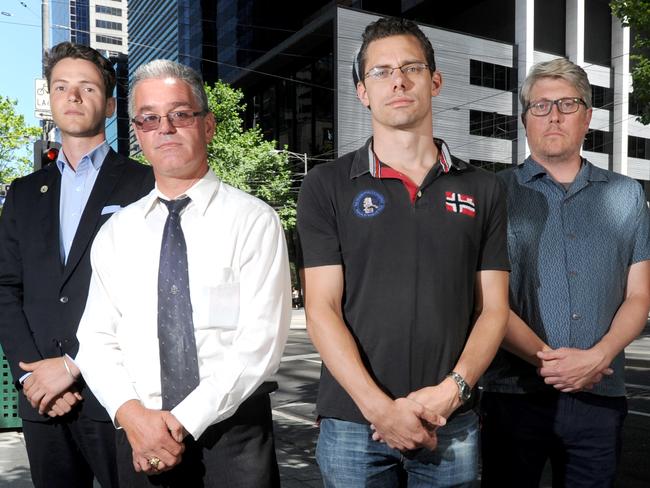
Dow nods at Bougias’ recollection of the man on his hands and knees, forehead bowed to the footpath, bent in prayer alongside three policemen with assault rifles. Their kinship was forged in chaos. Dow and Bougias were side by side that day, trying to make sense of the insensible.
Richardson listens as Dow waves his arms in a rush of words and feelings. They each want to understand, and each other’s recollections help fill the voids. This need to comprehend explains their questions about the alleged perpetrator, Dimitrious Gargasoulas. They are impatient with legal delays. They insist that the coronial inquiry — when it finally happens — explores every action, reaction, protocol and technology system in the 12 or more hours before a car changed their lives.
Richardson was further east on Bourke St. Despite his absence of first-aid training, he ran to a lady who had been bowled over by the car. He held her as she convulsed.
With him was Kristy Moore, who cradled the lady’s head and fretted about the tennis-ball sized bump. The car had brushed Moore as she squeezed against a wall and braced to be crushed. Moore then observed Richardson rushing to the lady and decided that she, too, must help.
LONG ROAD: Bourke St rampage survivors recall horrors of that day
Bourke St survivor in the swim a year on and looking ahead
MUST-READ: Angel of Bourke St reunited with victim she saved
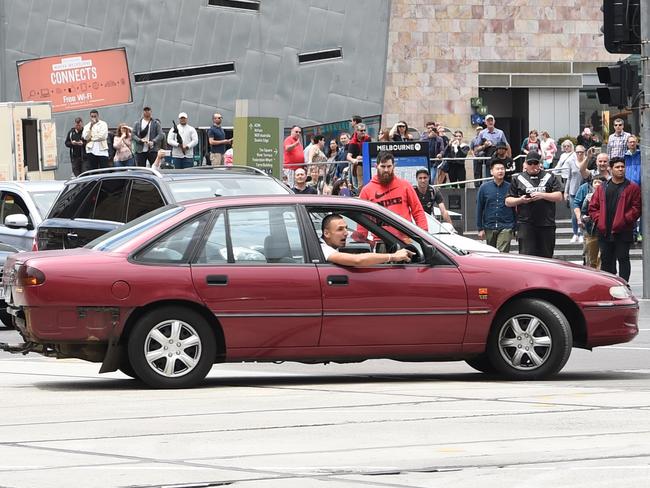
The woman lay with a broken pelvis. When she came to, groggy, she answered that she was not pregnant. The response pushed her down the emergency priority list. It was only when an off-duty GP asked her again, and she replied that she was 14 weeks’ pregnant, that her predicament received medical urgency.
Months on, Moore and Richardson were invited to a “welcome home” party. The woman had given birth to a baby boy more than three months’ premature. Richardson and Moore were treated as saviours. They were strangers before Bourke St; now, because of the horror, and because Richardson helped, there is a little boy whose middle name is Marc.
They are among the first responders who were untrained and ill-prepared. Many of them had been pursuing the dullest of errands. One was returning to work from Target, another had ducked out to Chemist Warehouse. After they jumped for their lives — as Moore puts it — they “snapped into action”.
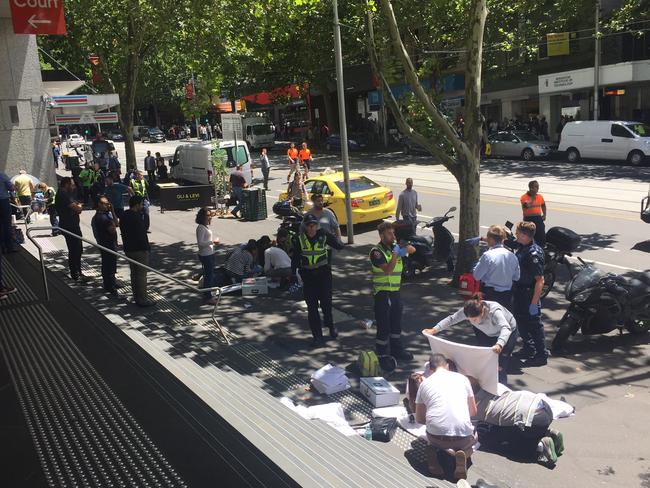
Most of them remain unsung to this day. They were ordinary people who answered phones and found blankets and placed bottled water into the shaking hands of police officers. They tended those people with critical injuries and comforted those people who did not survive.
Dow recalls limbs at right angles and puddles of blood. He looked up at crowds, watching silently and still, in scenes that reminded him of the Grand Final parade. The image separates him from them, the first responders from the rest of us. When he speaks at lunch about vomiting afterwards that day, the others smile knowingly in response.
They know about hypervigilance and lack of sleep. They have been taught in the spectre of PTSD: for a time after Bourke St, Moore fretted about shooters on the train when she travelled to and from work. They know that counsellors can help, though many avoided such treatments — Dow started sessions only when he wearied of crying when he had a drink. For months, Richardson remembered a scream, then silence.
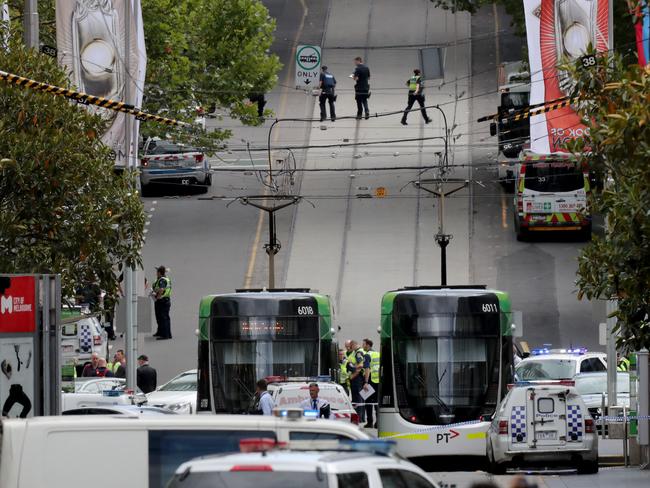
Talking about it with one another, as many do in a private Facebook group of 28-odd members, seems to help most. Groups have splintered into cliques, individuals have dropped out, but the core remains solid. They “keep an eye on each other,” Bougias explains. It is its own “kind of counselling”.
There is a sparkly eyed vividness to their thoughts, as if the film of self-protective amnesia has been wiped away after many months of thinking about the thuds and the shouts. They have now processed what they could not absorb. They feel like the lucky ones — and yet they feel altered, too.
Richardson, for one, now seeks to be more attuned to others. Glen Piper, who applied lifeguard training to helping the critically injured Erin Shi, speaks of an enduring bond.
Little changes stick. Richardson finds that he goes for a walk each Friday at about 1.30pm, without really knowing why. He has noticed that the Big Issue seller in Bourke St Mall has shifted his perch since his close call that day.
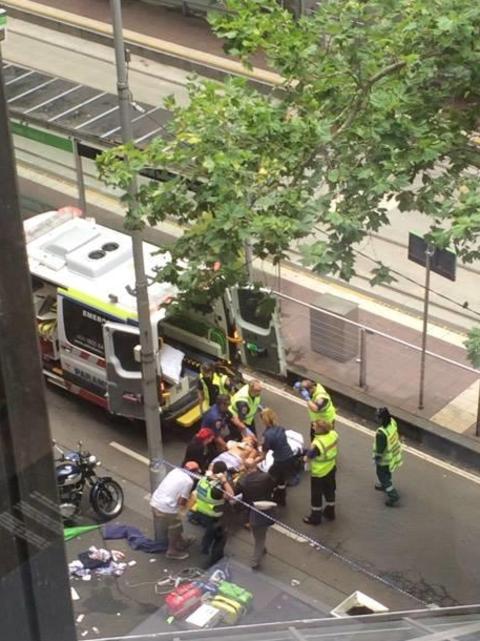

They look to get on, yet they still ponder the random choices that joined them. Moore had bought a skirt that day, and had dashed to catch the flashing man of the pedestrian traffic signal. Richardson had deliberately gone the long way to count steps on his new watch.
Dow had left a dreary meeting early. He watched on from the other side of Bourke St. A car, he first thought, in snapshots so muddled he can only scoff at his brain’s processing. What he rationalised as a “girl joy-riding” was a victim being tossed. His surf lifesaving training took over, then the shakes followed — they still strike his right hand whenever he now speaks in public.
“He’s shooting, he’s shooting,” he said, when shots echoed from William St. He then acquiesced to the calm authority of Bougias, whose cabbie gear Dow mistook for a 000 uniform. Bougias kept him useful.

Dow fumbled with phones that day, and forgot about his own when it was buried in his blood-soaked jacket under a victim’s head.
Richardson rang the pregnant woman’s husband.
“What are you talking about?” the husband replied to Richardson’s garbled explanation of events.
A few days later, when the woman herself rang to thank him for “saving my baby”, Richardson was overcome with emotion. He apologised for manhandling her on the street.
Her ordeal was just beginning. Confusion and fear marked coming days. Her husband waited hours to see her at the Royal Melbourne Hospital, not knowing if their unborn child had survived. Screws would be inserted in her cracked pelvis, surgeons mindful of her pregnancy. She spent eight weeks in hospital. Two weeks later, she was back in hospital, undergoing an emergency caesarean section. Her son was born at 24 weeks — he weighed 787 grams.
“It took us close to 4½ months until he was at a safe weight to go home,” she says.
Each day, she tries to mend while helping her son fight: “I am still going to rehab, physio, GP and counselling. I am recovering slowly. My son is doing well by the day.”

Chris Lassig was close to Richardson, though they didn’t meet until last Friday. Lassig, who works at the nearby Stroke Foundation, was the first to reach Nethra Krishnamurthy, whose husband Mohan was shouting that she was dead. Lassig thought so, too.
Krishnamurthy lay flat on her back, eyes open. Lassig recalls her striped jumper, spinning through the air. That’s not right, he thought. None of the collisions were, not the way the car kept going. For a long time, he felt guilty that he could not warn the victims ahead.
He comforted Krishnamurthy with a jacket of another civilian, Kelly. And he wondered what to do next. He was grateful for the arrival of Charlotte Galpin and Phoebe Hammond. They were trained in triage. He helped move Krishnamurthy into a recovery position. He spoke to her husband and he waited for the paramedics, which seemed far longer than it was.
Afterwards, he returned the jacket to Kelly, and went to his coffee shop to wash his bloodied hands. Then he returned to work.

The next few days were a kind of vigil for the first responders.
They cared greatly for the strangers they had tended to, but they had few insights into their condition. Lassig studied media reports for updates on Krishnamurthy’s critical condition.
To this day, he is still umming and ahhing. Krishnamurthy and her husband would welcome his call: Lassig knows this. And he would like to chat. But he hasn’t rung them yet. He doesn’t want to appear to be seeking their validation.
He now wears the label of alleged attempted murder victim. Moore wonders why she has not received the same legal standing, though she says there are bigger matters, one of which she wrote to friends a few hours after the rampage: “Today was a brutal reminder of how quickly life can be snatched away. Don’t leave anything unsaid.



